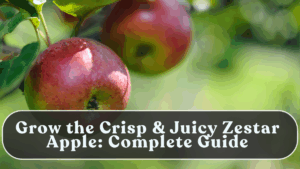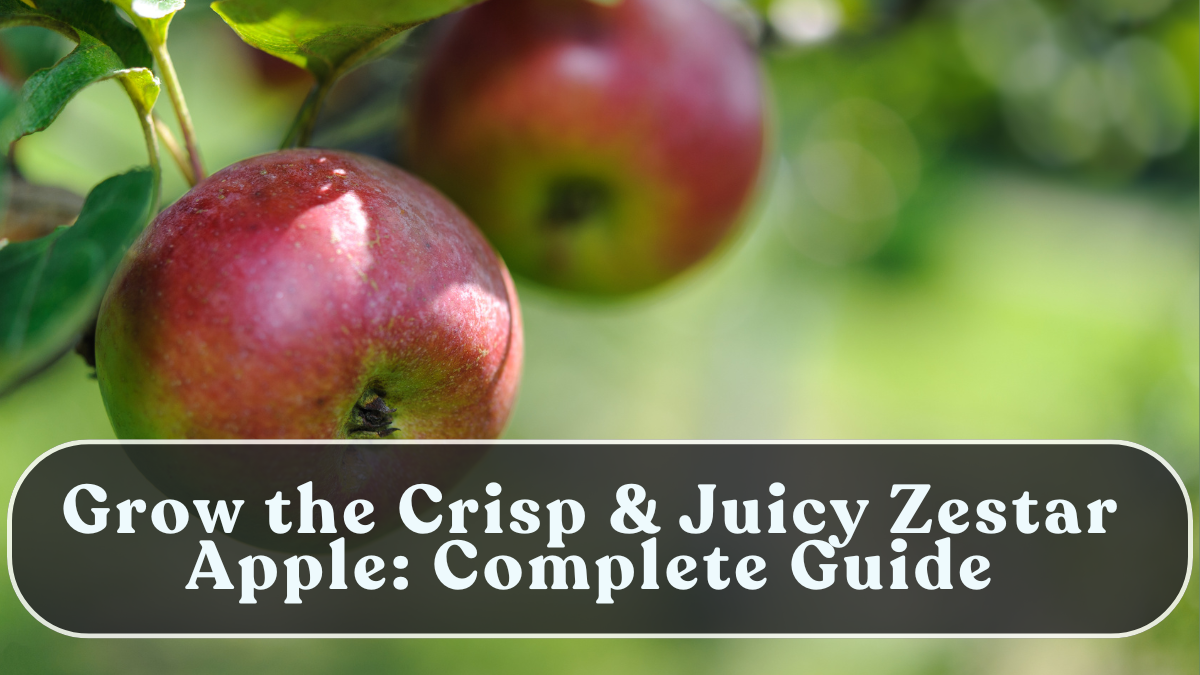The Zestar Apple is an early-season variety known for its crisp texture, sweet-tart flavor, and refreshing juiciness. Developed by the University of Minnesota, it’s designed to thrive in colder regions while producing exceptional quality fruit. If you’re looking to add a delicious and hardy apple tree to your home garden, growing Zestar apples is a perfect choice.
Here’s a complete step-by-step guide on how to plant, prune, and care for your Zestar apple tree for the best harvest.

About the Zestar Apple Variety
Zestar apples are round, medium-sized, and beautifully colored—bright red with a golden hue underneath. The fruit’s flavor is balanced with a pleasant mix of sweetness and tanginess, making it excellent for fresh eating, pies, and juices.
The tree is cold-hardy and performs well in regions with chilly winters, requiring 700–800 chill hours annually. It’s also known for ripening earlier than most apple varieties, typically by late August or early September.
Ideal Growing Conditions
Zestar apple trees grow best in temperate or cool climates.
-
Temperature: 5°C–25°C is ideal.
-
Sunlight: At least 6–8 hours of direct sunlight daily for healthy fruiting.
-
Soil Type: Well-drained loamy soil with good fertility.
-
pH Level: Slightly acidic (6.0–6.8).
Avoid waterlogged or heavy clay soil, which can cause root rot and poor fruit set. If soil drainage is poor, consider planting on a raised bed or mound.
Planting Your Zestar Apple Tree
-
Timing: Plant bare-root trees in late winter or early spring while dormant. Container-grown trees can be planted anytime the soil isn’t frozen.
-
Site Preparation: Dig a 2×2 foot hole, loosen the soil, and mix in organic compost or aged manure.
-
Planting Depth: Place the sapling so the graft union sits 2 inches above the soil surface.
-
Watering: Water thoroughly after planting and mulch around the base to retain moisture.
Keep at least 15–20 feet spacing between trees for proper airflow and sunlight.
Pollination and Fruiting
Zestar apples are not self-pollinating, so they require a compatible variety nearby for cross-pollination—such as Honeycrisp, Gala, or McIntosh. Bees are the main pollinators, so avoid spraying pesticides during blooming.
Trees begin producing fruit within 3–4 years of planting and can yield abundantly once mature.
Watering and Fertilizing
Water the tree deeply once a week, ensuring the root zone remains moist during dry periods. Avoid shallow watering—it encourages weak roots.
Fertilize twice a year:
-
Spring: Use compost or an organic balanced fertilizer (10:10:10) to support new growth.
-
Summer: Apply potash or bone meal to enhance fruit sweetness and size.
Avoid excess nitrogen, which leads to leafy growth rather than fruit production.
Pruning and Training
Pruning helps shape the tree and improve yield.
-
When to prune: Late winter or early spring before buds open.
-
How to prune: Remove dead, crowded, or downward-facing branches.
-
Maintain an open-center structure to allow sunlight penetration and airflow.
Train young trees using bamboo stakes or wires to encourage strong, upright growth.
Pest and Disease Management
Zestar apples are moderately resistant but can face issues like apple scab, codling moth, and aphids.
-
Use neem oil spray every 15 days during the growing season.
-
Keep the area weed-free and clear fallen leaves to reduce fungal risk.
-
Encourage beneficial insects like ladybugs to control pests naturally.
Proper pruning and soil drainage also prevent fungal buildup.
Harvesting and Storage
Zestar apples are typically ready to harvest by late August to early September.
-
Harvest when the fruit turns red with a yellow undertone and feels firm.
-
Gently twist or lift apples to remove without damaging stems.
They store well for up to 6 weeks in a cool, dark place or can be refrigerated for longer shelf life.
Taste and Culinary Notes
Zestar apples have a crisp bite and a balanced sweet-tart profile with a hint of brown sugar flavor. They’re excellent for:
-
Fresh snacking
-
Baking and pies
-
Juices and ciders
Their firmness holds up beautifully when cooked, making them a versatile kitchen fruit.
Conclusion
The Zestar apple tree is a perfect pick for gardeners who want early, flavorful harvests and reliable growth in cooler climates. With proper pruning, cross-pollination, and steady watering, your tree will reward you with baskets of juicy, vibrant apples each year.
Hardy, productive, and full of flavor—Zestar apples are proof that great things come early in the season.
FAQs
How long does it take for a Zestar apple tree to bear fruit?
Usually 3–4 years after planting, depending on soil and climate.
Does the Zestar apple tree need a pollinator?
Yes, it requires another apple variety like Honeycrisp or Gala nearby for cross-pollination.
What’s the best soil type for Zestar apples?
Loamy, well-draining soil rich in organic matter with a slightly acidic pH.
How often should I water it?
Water once a week deeply, especially during dry spells.
When do Zestar apples ripen?
They ripen early—by late August or early September, ahead of most apple varieties.
